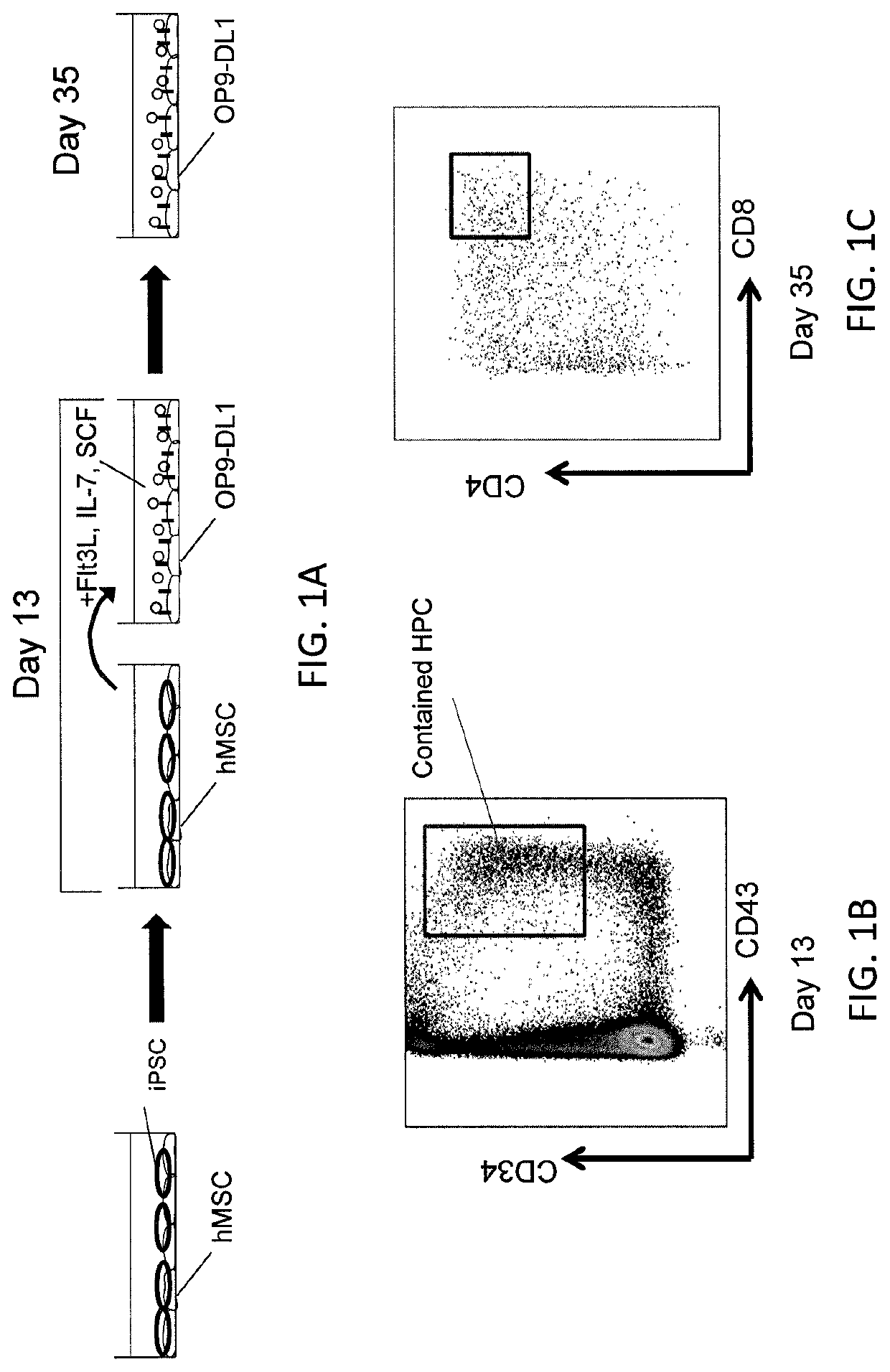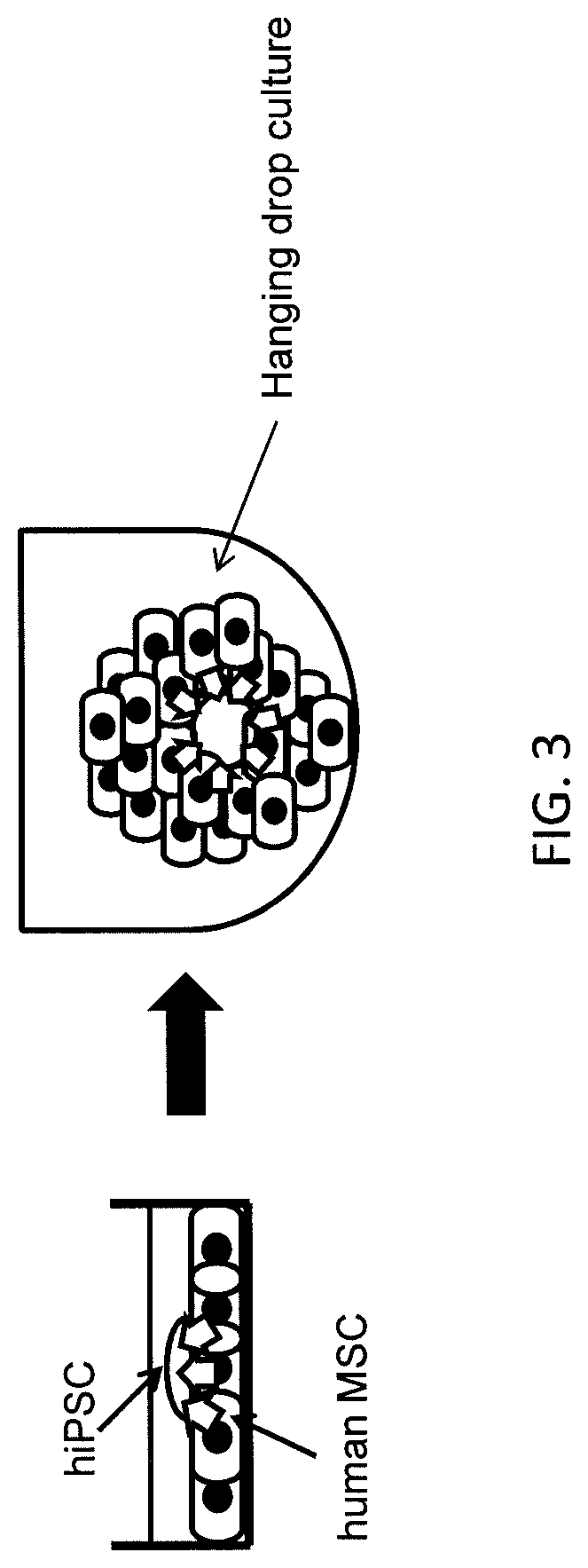Methods of preparing hematopoietic progenitor cells in vitro
a technology of hematopoietic progenitor cells and in vitro preparation, which is applied in the field of methods of preparing hematopoietic progenitor cells in vitro, can solve the problems of inability to produce in vitro hematopoietic progenitor cells,
- Summary
- Abstract
- Description
- Claims
- Application Information
AI Technical Summary
Benefits of technology
Problems solved by technology
Method used
Image
Examples
example 1
[0112]This example demonstrates that co-culturing iPSC with hMSC can produce CD34+CD43+ cells without the use of cytokines.
[0113]A 3D hanging drop culture (FIG. 3) was used to promote formation of the sac-like structures that are involved in differentiation of hiPSC into human HPC (shown in FIGS. 2A-2B) and provide a better scaffold for iPSC differentiation.
[0114]A single cell suspension from iPSC was cultured on MATRIGEL membrane matrix coated dishes in ESSENTIAL 8 xeno-free media (Gibco, was prepared (0.8×105 cells / mL), as shown in FIG. 4. The cell suspension (5 mL) was added to each AGGREWELL 400Ex well, and the cell mixture was immediately pipetted gently several times to distribute the cells evenly throughout the wells. The AGGREWELL 400Ex plate was centrifuged at 100 g for 3 minutes to capture the cells into the microwells. The cells were incubated at 37° C. overnight, after which EBs had formed (FIG. 4).
[0115]Small EBs were collected from the AGGREWELL 400Ex plate by gently p...
example 2
[0118]This example demonstrates that CD34+CD43+ cells derived from hematopoietic spheroids have potency to produce T cell progenitors.
[0119]PERFECTA 3D hanging drop cultures were prepared containing either (1) EBs with the cytokines listed in Example 1, (2) EBs without the cytokines, (3) hematopoietic spheroids with the cytokines listed in Example 1, or (4) hematopoietic spheroids without cytokines, as described in Example 1. To evaluate the differentiation potency toward T cell lineage of the CD34+CD43+ cells obtained from the EBs and hematopoietic spheroids, the CD34+CD43+ cells were added to an OP9-DL1 co-culture system, as shown in FIG. 8A. On day 41, the resulting cells were subjected to FACS analysis. As shown in FIG. 8B, it was found that the CD34+CD43+ cells produced in hematopoietic spheroids, with or without added cytokines, can generate CD4+CD8+ cells (immature T cells) consistently. However, the EBs+ cytokines could not (FIG. 8B).
example 3
[0120]This example demonstrates that hematopoietic spheroids cultured in bioreactors can produce CD34+CD43+ cells.
[0121]Hematopoietic spheroids were prepared from hiPSC-derived EBs as described in Example 1, and added to the ABLE Bioreactor Magnetic Stir System 3D magnetic stir (Reprocell, Beltsville, Md.) and disposable bioreactor to allow for mass production (FIG. 9A, Day 2). Hematopoietic spheroids (2000-2400) were cultured in 30 mL of differentiation medium in the bioreactors. On day 13, HPC were harvested and subjected to FACS analysis. As shown in FIG. 9B, 5-7% of cells generated from the hematopoietic spheroids cultured in the bioreactors expressed CD34+CD43+.
[0122]As shown in FIGS. 15A-15D, the expansion and differentiation of iPSC in the spheroids were enhanced by the stirred-suspension bioreactors as compared to those that were cultured in the plates.
PUM
 Login to View More
Login to View More Abstract
Description
Claims
Application Information
 Login to View More
Login to View More - R&D
- Intellectual Property
- Life Sciences
- Materials
- Tech Scout
- Unparalleled Data Quality
- Higher Quality Content
- 60% Fewer Hallucinations
Browse by: Latest US Patents, China's latest patents, Technical Efficacy Thesaurus, Application Domain, Technology Topic, Popular Technical Reports.
© 2025 PatSnap. All rights reserved.Legal|Privacy policy|Modern Slavery Act Transparency Statement|Sitemap|About US| Contact US: help@patsnap.com



